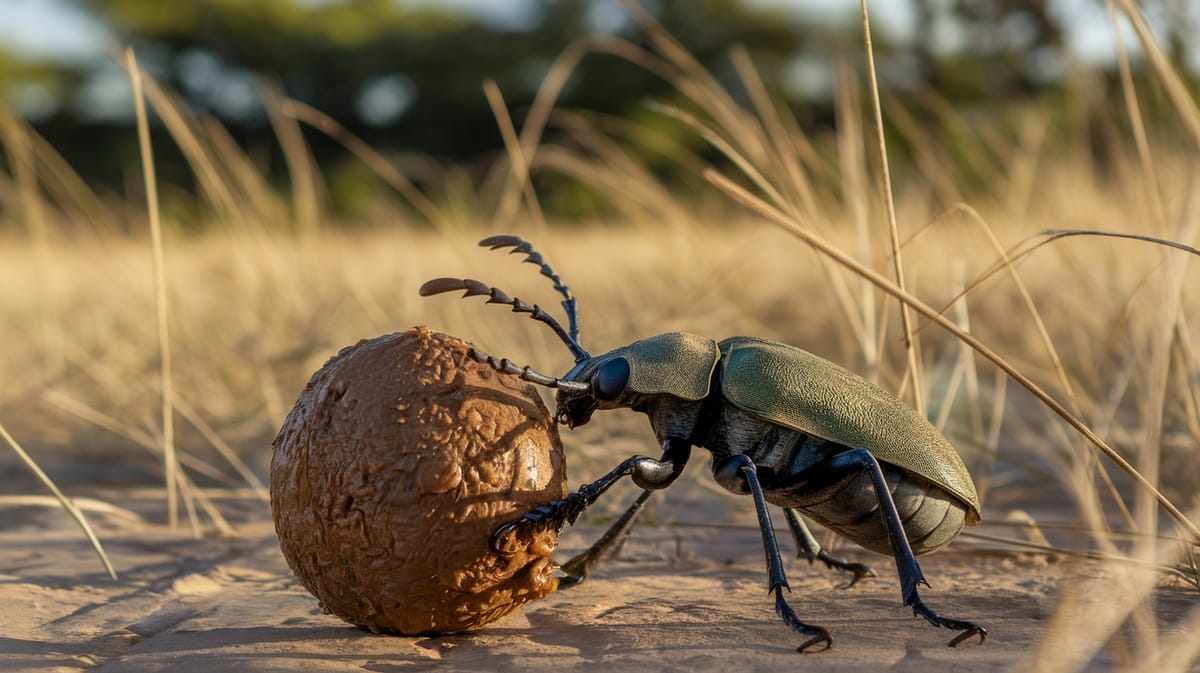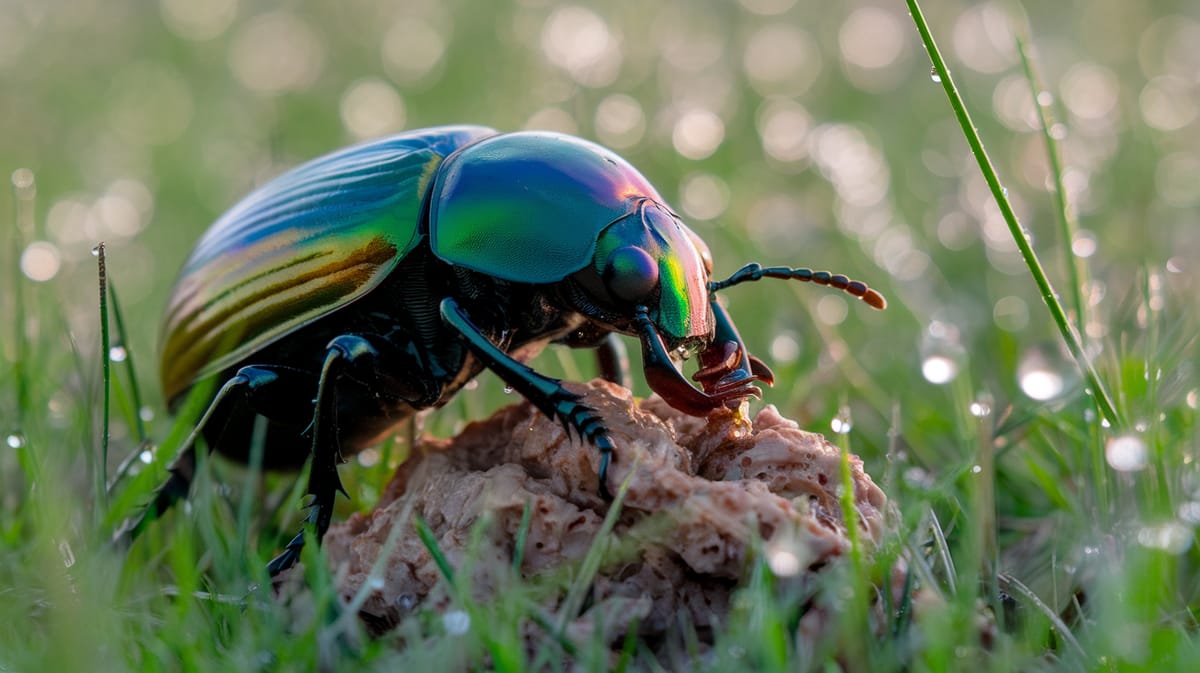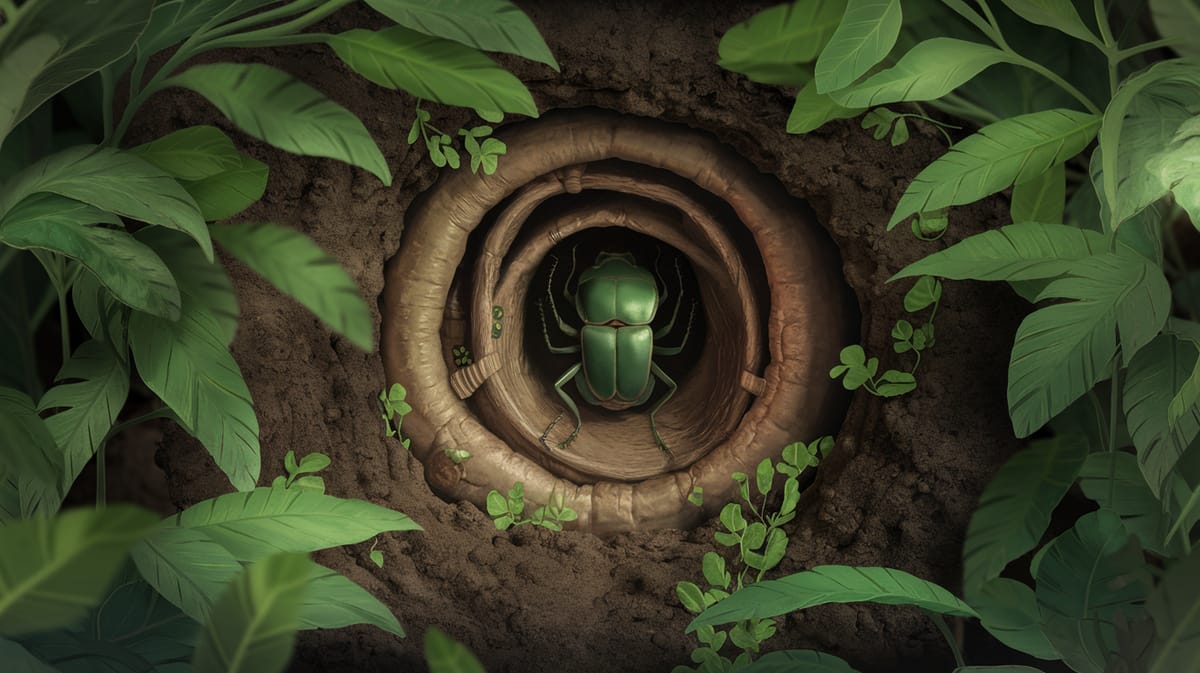Dung Beetle
Rolling balls of dung with unmatched strength, the Dung Beetle cleans up nature's waste while supporting nutrient recycling. These industrious insects are remarkable recyclers and environmental allies.

Key Insights at a Glance
Did You Know?
Taxonomy & Classification
Dung beetles have evolved unique adaptations like rolling and burying dung, playing a crucial role in nutrient cycling and waste decomposition. Let's understand the evolutionary journey and classification of these remarkable decomposers.
Global Diversity
With over 6,000 species distributed across every continent except Antarctica, dung beetles exhibit impressive adaptability to various ecosystems.
Ancient Survivors
Originating over 30 million years ago, dung beetles have thrived through significant climatic changes, showcasing their evolutionary resilience.
Lifecycle and Growth
A remarkable journey of transformation from Egg to Adult.
Egg
Eggs are laid in dung balls, providing a nutrient-rich environment that ensures the developing larvae's survival and growth.
Larva
Larvae feed on the dung ball, growing rapidly while shedding their skin multiple times to accommodate their increasing size.
Pupa
Pupation occurs within the dung ball, where larvae undergo metamorphosis, transforming into adult beetles with fully developed structures.
Adult
Adult dung beetles emerge to find mates and continue the cycle, playing a critical role in nutrient recycling and soil aeration.
Dietary Habits
A specialized feeder with unique adaptations, this beetle primarily relies on animal feces, using it for food and nesting.
| DIET TYPE | DESCRIPTION |
|---|---|
| Primary Diet | Feeds mainly on fresh animal dung, rolling and burying it for sustenance and reproduction. |
| Secondary Diet | Consumes decaying organic matter and fungi, supplementing its diet when fresh dung is scarce. |
| Occasional | Occasionally feeds on rotting fruit or carrion, opportunistically expanding its diet in limited resource situations. |

Behaviour and Adaptations
Discover the fascinating adaptations that enable the Dung Beetle to thrive in its unique ecological niche.
Dung Ball Rolling
Expertly rolls dung balls over long distances to secure food and breeding sites.
Celestial Navigation
Uses the Milky Way to navigate and find its way home.
Resource Recycling
Efficiently recycles waste material, contributing to nutrient cycling in ecosystems.
Ecosystem Impact
Dung Beetles play a crucial role in maintaining ecological balance through their unique contributions.
Nutrient Recycling
They break down animal waste, enriching soil and promoting plant growth.
Soil Aeration
By burrowing, they naturally aerate soil, enhancing water infiltration and root growth.
Pest Control
They reduce fly populations by eliminating breeding grounds in animal dung.
Conservation Challenges
Addressing the major threats to Dung Beetle populations effectively.
Habitat Loss
Urban development and deforestation reduce dung beetle habitats.
Chemical Exposure
Pesticides and fertilizers disrupt beetles' ecosystems and health.
Climate Change
Altered weather patterns affect beetle foraging and reproduction.
Frequently Asked Questions
How long do Dung Beetle live?
Dung beetles typically live for three to six months, depending on the species and environmental conditions. Factors such as food availability and habitat can influence their lifespan. They spend most of their life cycle in the larval stage, developing into adults in favorable conditions.
What do Dung Beetle eat?
Dung beetles primarily eat feces. They roll, bury, or consume dung, which provides necessary nutrients for their survival. Some species also consume decaying leaves and fruits, but dung remains their main food source. This behavior plays a crucial role in nutrient recycling and soil aeration.
Are Dung Beetle poisonous?
Dung beetles are not poisonous. They pose no threat to humans or animals. While they handle and consume dung, they do not transmit diseases to humans. Their role in breaking down animal waste actually benefits ecosystems by reducing waste and promoting soil health.
Are Dung Beetle endangered?
Most dung beetle species are not endangered, but some face threats from habitat loss, agricultural practices, and climate change. Conservation efforts focus on preserving their habitats to maintain their ecological roles. It's essential to monitor specific species that are vulnerable or declining.
What do Dung Beetle symbolize?
Dung beetles often symbolize renewal, transformation, and resourcefulness. In ancient Egyptian culture, they were associated with the god Khepri, symbolizing creation and regeneration. Their ability to recycle waste and contribute to ecosystem health gives them a positive symbolic meaning in various cultures.
Do Dung Beetle bite?
Dung beetles do not bite humans. They are not aggressive and have no reason to bite. These insects focus on their ecological role of breaking down dung rather than interacting with humans or animals. Their mandibles are adapted for handling dung, not for biting.
What color are Dung Beetle?
Dung beetles come in various colors, including black, brown, and metallic green or blue. The coloration depends on the species. Some may have iridescent or shiny exoskeletons, which can be quite striking. Their colors often help them blend into their environments.
Does a Dung Beetle have wings?
Yes, dung beetles have wings. They possess two pairs: the hardened forewings called elytra and the membranous hindwings used for flying. The elytra protect the delicate hindwings and abdomen when the beetle is not flying. Many species are strong fliers.
What does a Dung Beetle look like?
Dung beetles are small to medium-sized beetles with a robust, rounded body. They have distinctive, strong legs adapted for digging and rolling dung. Their head may feature horns or other protuberances, especially in males. Coloration varies by species, ranging from dull to iridescent hues.
Is a Dung Beetle an insect?
Yes, a dung beetle is an insect. They belong to the order Coleoptera, which includes all beetles. Like other insects, dung beetles have a segmented body consisting of a head, thorax, and abdomen, along with six legs and a pair of antennae.
Related Insects
Discover insects with similar characteristics to Dung Beetle - including shared habitats, diets, and taxonomic classifications
Share this profile
Help others discover Dung Beetle
